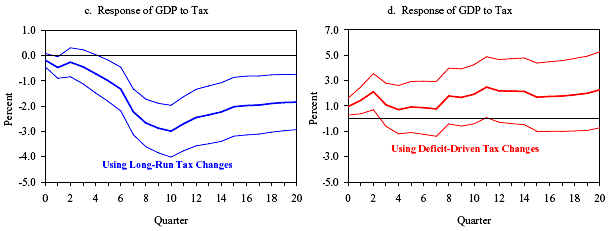TAXES AND CHRISTINA ROMER….Brad DeLong says of fellow Berkeley economics professor Christina Romer — who has just been appointed by Barack Obama as head of the CEA — that she is “very good at explaining economics.” That’s good, because I have a question.
Last year Christina and David Romer wrote a paper that attempted to quantify the effect of tax changes on economic growth. I read it at the time and didn’t understand it. I read it again a few minutes ago and I still don’t understand it. So my question is: Can you please explain your paper titled “The Macroeconomic Effects of Tax Changes: Estimates Based on a New Measure of Fiscal Shocks”?
Here’s my understanding of what the paper says. Basically, the Romers looked at every tax measure enacted since 1945 and classified them into two groups. The first group they call endogenous. These are tax changes made in response to current or future economic conditions, including responses to spending changes or recessions. Since the effect of these tax changes is difficult to separate from the effects of the events being responded to, they are discarded.
The second group they call exogenous. These are tax changes designed either to reduce a deficit or to raise long-term growth. Since they aren’t motivated by current or future economic conditions, their effect on the economy is untainted by external factors.
The Romers use this second group to calculate the effect of tax changes on economic growth without confounding factors, and their conclusion is that a tax increase of 1% of GDP reduces output three years later by nearly 3%.
Aside from the difficulties inherent with this kind of classification, I’ve got a few problems with this. First, their methodology eliminates a whole bunch of tax changes simply because their effect is hard to calculate. This might make practical sense, but doesn’t it also introduce a whole new kind of bias?
Second, it assumes that if politicians say a tax increase is designed to spur economic growth or reduce the deficit, then that’s what it’s for. But ever since 1980, conservative politicians have said this about practically every tax cut whether it’s true or not. For this reason, the Romers tag nearly every tax change since 1980 as exogenous. Doesn’t this make their post-1980 analysis a little slippery since it essentially includes all tax changes while the pre-1980 analysis doesn’t?
Third, it doesn’t take into account different kinds of tax changes. If, say, exogenous changes tend to be capital gains cuts while endogenous changes tend to be payroll tax increases, wouldn’t you need to take that into account?
Fourth, there have been tax changes practically every year for the past 50 years. How do you separate the effects of one tax change from another?
Fifth, can it really be true that a 1% tax increase produces a 3% GDP reduction over the long term? European countries tend to have total tax rates that are upwards of 15% higher than ours, which should mean their GDPs are 45% lower. For the most part, however, GDP per hour worked in Europe is only modestly lower than ours.
Anyway, those are my questions. I’ve found very little discussion of the paper on web (see here and here for a couple of exceptions) and I’m curious to know what the economics profession in general thinks of it. Can anyone point me in the right direction?
POSTSCRIPT: One of the Romers’ conclusions, by the way, is that tax increases designed to reduce an inherited deficit have a positive impact on economic growth. So if Obama ever does raise taxes, expect this to be the reason he gives for it. Luckily for him, it will probably be true.


















